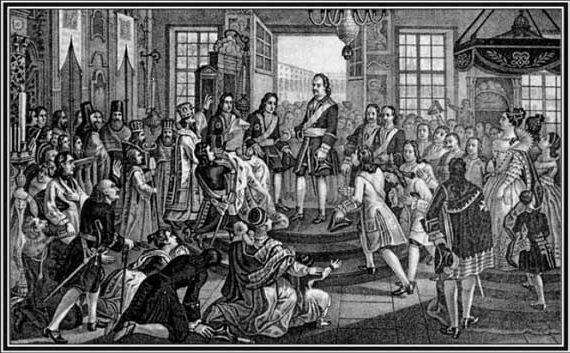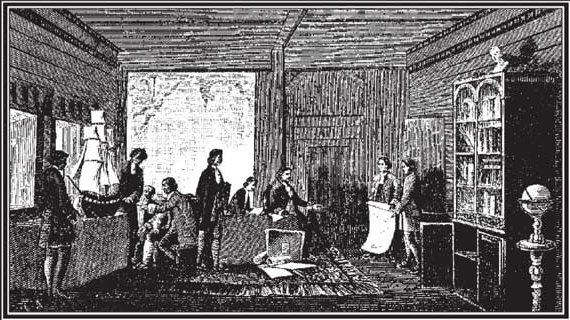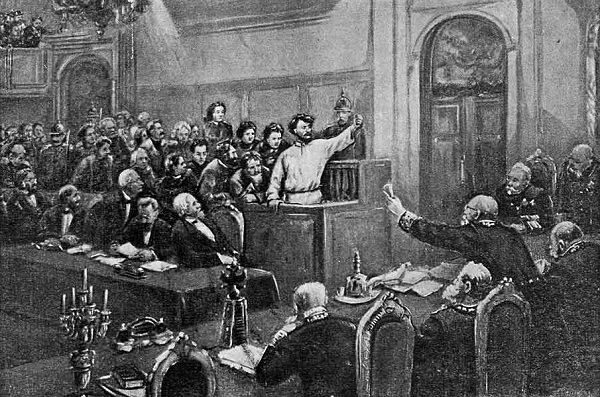The state management system in Russia required updates. As a result, a noble-bureaucratic centralized apparatus was formed. Gradually, the Boyars' Duma began to lose its significance until it completely ceased to exist, and then all legislative, judicial, and executive powers passed to Peter 1. Special imperial decrees introduced fundamentally new systems of state administration - the establishment of the Senate and colleges was established. This article will talk about their purpose, structure and coordination.
Senate Creation
On February 22, 1711, Peter 1, by his decree, established a state body of a new type - the Governing Senate. Initially, it included 8 people from the immediate circle of the king. These were the largest political figures of that era. Senators were appointed and removed according to the personal decrees of Peter. This supreme governing body had to act constantly and never interrupt its work.
The Senate is a collegial council, which was engaged in the administration of justice, the solution of financial and other issues related to various sectors of the economy. This was an advisory, judicial and managerial institution. Its members submitted to the monarch various questions regarding the legislative process.
Those normative acts, which were issued by the Senate, had no legal force. At meetings, bills were only discussed and interpreted. The Senate was at the head of the system, and all the collegiums subordinated to him, who monthly submitted statements of all outgoing and incoming cases.

The establishment of the first collegiums
In 1711, a certain officer, Johann Friedrich Bliger, drafted his own draft regarding the further development of mining in Russia and submitted it to Peter 1 for consideration. The author called his document a collegium. The following year, another German officer interested the king in his proposal. It concerned the organization of commercial and audit collegiums. Peter appreciated these propositions, and the establishment of the first collegiums began. The date of the signal decree is February 12, 1712. It concerned the creation of the Commerce Collegium, which dealt with customs, shipping, and foreign trade.
According to the imperial decree, a commission was drawn up, which included three foreign and several Moscow merchants, as well as six suburban residents. They were instructed to develop basic rules and clauses on the collegium of commerce. This commission worked for almost two years and drew up a trade document. After that, she took up the customs charter. Unfortunately, no further information has been preserved about its further work.
Since that time, the creation of collegiums, charters and a whole series of other transformations began, after which they gradually began to replace the already outdated system of orders. It was at this time that the name and character of the future institutions of the new power system became apparent.

Further development
I must say that the establishment of the colleges by Peter the Great and their substitution of orders was very slow and sluggish. But when in 1715 the tsar became clear to the outcome of military operations with Sweden, he began to become more actively interested in the internal affairs of the state. It is known that in his book for notes under the date of January 14 of the same year, a note was made about three colleges, and by March 23 there were already six. It is assumed that Petra was prompted by the reading of the project on the reorganization of the state administrative apparatus of the now unknown author.
The document proposed introducing the establishment of colleges in Russia, which would concentrate all the affairs on the arrangement of the country. The project mentioned seven departments related to justice, trade, foreign affairs, mining, the army, taxes and government spending. The management of structures was supposed to be handed over to individual senators. The author of this project cited Sweden as an example, where this system already existed, which was considered the best in Europe.

The commission of Peter
In April 1715, he ordered Prince V. Dolgorukov, the then Russian ambassador in Denmark, to somehow get written or printed charters of the colleges there. The following year, the king takes on the service of a certain Fick, well versed in justice authorities economics and police affairs. In addition, he was well aware of civil and state law. It is precisely Peter 1 who sends him abroad so that he already thoroughly examines the entire control device on the spot.
Another royal order was received by the Vienna resident Abram Veselovsky. He was supposed to find abroad and invite clerks with knowledge of languages to serve in Russia. I must say that Peter 1 did not skimp and paid foreign officials decent remuneration in exchange for valuable information about their institutions. He appreciated such knowledge more than book knowledge.

Training
In the next two years, the tsar spent abroad, and it seemed that without him the establishment of collegia would cease altogether. But that was not so. Preparations for organizing a new system were in full swing. Everyone who was involved in this work worked tirelessly, including Peter himself, who was sometimes present in the Danish colleges, reviewing cases and rewriting the rules of office work.
In early 1717, Fick arrived in Amsterdam to the king to inform him that he had finished studying the Swedish state system. Peter sends him to Bruce so that he announces through the provincial leadership and the Senate that the Swedish captives, knowing the civil service, can enter, if they want, to Russian collegium posts. Prisoners in Russia did not have a sweet life, so many accepted the invitation, and they were promised a decent reward.
Collegium Register
All the developments related to the transformation of the state system were collected by Fick and transferred to Bruce. Shafirov and Yaguzhinsky took an active part in this matter. In October, Peter 1 himself returned to Russia and the next stage of work began - the direct establishment of collegiums. The year 1717 was decisive, because on the basis of all the materials collected, the register was finally compiled, as well as the staff of all units, which the king approved on December 1 of that year. Already on the 15th, Peter 1 signed a decree on the appointment of presidents and their deputies.
How many colleges were there under Peter 1? First, 9. Admiral Apraksin, Chancellor Golovkin and Field Marshal Menshikov, remained to head their offices, which from that moment began to be called in a new way. The first of them remained at the head of the Admiralty, the second - of foreign affairs, and the third - of the military collegium. From the former local, zemstvo and detective court orders, the Justits College was formed, which A. Matveev was entrusted with managing. The president of the Chamber College was Prince D. Golitsyn, the Staff College - I. Musin-Pushkin, the Audit College - Y. Dolgoruky, the Commercial College - P. Tolstoy, Manufactory and Berg College - Y. Bryusov. All these units had to be arranged and formed anew.
But the establishment of collegia did not end there. The date of January 18, 1722 was marked by the release of a new decree on the creation of the 10th in a row, patrimony, in charge of land management and all other related issues.

Structure
The new units were to consist not only of domestic, but also of foreign members.Russians were given the posts of presidents and their deputies - vice-presidents, as well as 4 posts of advisers and assessors, one each - secretary, notary, actuary, registrar, translator and clerk of three articles. Foreigners were assigned in one place assessor or adviser and secretary.
The collegium institutions were to begin their work only in 1719, and before that time all the necessary documents, rules, etc. were drawn up. In addition, staff had to be found. The tsar’s decree, which was handed over to the presidents, stated that they could not accept either their relatives or friends at their posts. For this, it was proposed to select 2 or 3 candidates for a seat and present them to the collegiums, and there they would already select one of them by balloting.
Device difficulties
Peter gave his subordinates, put at the head of the colleges, only a year to form the units entrusted to him, but for now, all the departments worked in the old mode. The establishment of the colleges was very sluggish, while the king was away. When he returned, he realized that some presidents did very little, while others did not begin their work at all. Peter was very angry and even threatened them with a club. Seeing this turn of events, Bruce soon abandoned the device of new organs. He was replaced by Fick.

Beginning of work
In 1718, the staff of the lower ranks of the collegiums was practically staffed. Most of them were taken from old orders. A year later, we finished with the composition and approval of all the posts and regulations of most of the colleges. Finally, in 1720, work on the device was completed. The general regulation saw the light, in which the general rules of the collegiums were spelled out.
With the creation of the new body, that gap in state institutions was filled, thanks to which the Senate was exempted from considering petty cases coming from private individuals and was concerned only with legislative issues and urgent state affairs.

Establishment of ministries
Over time, the colleges began to slow down the development of the state, since bureaucracy in them reached its peak. Finally, on September 8, 1802, at the initiative of Alexander I, the Manifesto on the Establishment of Ministries was published. A total of 8 such units were created, each of which was responsible for its field of activity: naval forces, military forces, internal affairs, justice, finance, commerce, foreign affairs and public education.
All ministries had their own structural units, which were built according to the functional principle. Initially, they were called expeditions, and then renamed into departments. For their well-coordinated activities, special meetings were convened, called the "Committee of Ministers", where the emperor himself was quite often present.
Rights and obligations of managers
The establishment of ministries instead of colleges laid the foundation for sole authority and the same responsibility. This meant that the high-ranking official himself managed the department entrusted to him with the help of the office and the institutions that were directly subordinate to him. In addition, for all the mistakes made in his ministry, he also answered personally.
In addition, to discuss cases of national importance, the “Permanent Council” was also created, which included 12 members of the government. He replaced the temporary and occasional meetings held during the reign of Catherine 2 and Paul 1.
9 years after the establishment of the ministries, their rights and procedures were established. Each head of his department had from one to several deputies (comrades) who were members of the State Council and the Committee of Ministers. Their duties also included a mandatory presence in the Senate. Each specialized paperwork was carried out in ministerial offices. This order was maintained until the completion of the October Revolution of 1917.Under Soviet rule, people's commissariats were created on the basis of imperial ministries.








